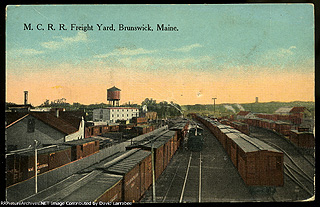A TrainRiders/NE Editorial: Brunswick Facts Outweigh Misleading Statements
- Details
- Created: 29 March 2013 29 March 2013
A Response to Senator Gerzovsky's
Letter of Complaint to NNEPRA
by Wayne Davis, TrainRiders/NE Chairman
(Editor's Note: Sen.Gerzovksy's letter can be read here.)
Maine Senator Stan Gerzovsky’s letter to NNEPRA strongly opposing the siting of the Brunswick layover facility just south of the current Brunswick station clearly reflects the concerns of some of his constituents who have chosen to live beside the train yard at which the facility will be located.
Currently, no indoor layover facility exists in Brunswick, which means that, the Downeaster diesel engines must be kept running to prevent the diesel fuel from congealing and becoming unusable when the temperature is below 40 degrees. Given the Downeaster’s current schedule, at least one Downeaster locomotive must remain idling several hours a day in Brunswick. Idling would not be required if the locomotive could be indoors. The Senator and some of his constituents, however, feel that one of two other proposed sites would be preferable if for no other reason than that they are not located in their backyards.
In doing so, the Senator and his constituents both ignore the disadvantage of these other sites and misstate many facts, which include the following:
1. The letter states that the facility will be built near tracks that were “never used-nor ever intended to be used-for this purpose”.
WRONG! The proposed site has been used as a train yard since the mid to late 1800’s. As recently as the 1970’s, the site consisted of numerous rail sidings with a capacity of up to 95 cars and also included a railroad office, a crew quarters and equipment storage buildings. More importantly, the site has been, and continue to be, zoned for rail and commercial use by the Town of Brunswick, and the location of a rail layover facility at this site is consistent not only with applicable zoning requirements, but also with the Town’s Comprehensive Plan for Development. The site has been, and continues to be, a site for interchange of freight trains between the Rockland rail branch operated by Maine Eastern Railroad and Pan Am Railway’s rail line going south from Brunswick to Portland.  The apparent volume of traffic handled by the Brunswick rail yard in its early years is obvious as shown in a postcard from the early 1900's (A larger version of this postcard from the 1920's is available online.) As one can see in this picture of the northern end of the rail yard, congestion is obvious, though the rail yards stretched roughly from Maine Street to beyond Church Road. Even today, the site contains numerous active tracks plus ongoing activity up and down in the yard. The existing activity and the available uses under applicable zoning requirements, should have shown potential purchasers of nearby residences that the yard was active and would continue to be used for railroad purposes.
The apparent volume of traffic handled by the Brunswick rail yard in its early years is obvious as shown in a postcard from the early 1900's (A larger version of this postcard from the 1920's is available online.) As one can see in this picture of the northern end of the rail yard, congestion is obvious, though the rail yards stretched roughly from Maine Street to beyond Church Road. Even today, the site contains numerous active tracks plus ongoing activity up and down in the yard. The existing activity and the available uses under applicable zoning requirements, should have shown potential purchasers of nearby residences that the yard was active and would continue to be used for railroad purposes.
(Below is a Google Earth image of the layover site.)

2. The letter indicates that the “proposal is to put an industrial-use facility in a residential neighborhood”.
WRONG! For well over a century, the yard has been utilized for rail purposes. The real question is why a residential neighborhood was expanded near what has, for over 100 years, always been an industrial site.
3. The letter indicates that choosing this site for the layover facility is “an irresponsible use of taxpayer money especially when several alternate sites were proposed that would’ve had a far lesser impact on residents.”
WRONG! Choosing either of the two other sites proposed for the layover facility in Brunswick would itself have been irresponsible. Using the alternate site, located in the Brunswick Industrial Park, would have required filling what is now essentially a huge hole in the ground in an area which included wetlands. The cost of preparing that alternative site would have made the project unaffordable.
Using the second alternate site, located in the Cooks Corner area north of downtown Brunswick, would have been inconsistent with Brunswick’s zoning requirements and its Comprehensive Plan. Perhaps more importantly, however, this site is located on non-signaled track which would have required over half an hour of additional travel time for each train between Brunswick station and the layover facility, resulting in several hours’ worth of additional fuel, equipment use and crew time each day. This, plus other operational shortfalls, would have translated into another unaffordable project. In addition, if this site had been chosen, it would have resulted in added motor vehicle idle time as trains crossed one of the busiest high-volume highway crossings in the state. To have chosen either of the alternatives sites would have increased taxpayer costs in significant and adverse ways. Clearly, in choosing the proposed site NNEPRA acted responsibly to minimize taxpayer cost and ensure the survivability of the Downeaster service.
4. The letter indicates that noise and air pollution resulting from idling of trains for upwards of five hours a day will result in decreased property values and increased health risks.
WRONG! Construction of the layover building will eliminate the need for long-term idling of trains since they will be housed indoors at that facility. A study performed for NNEPRA (available on their website: http://www.amtrakdowneaster.com/projects/brunswick-layover-facility) estimated that even after the service is increased to six roundtrip per day (only one roundtrip between Brunswick and Boston occurs now), utilization of the layover building would result in no more that 30 minutes of total idling time each day, and that this idling time would be inside the facility. That same study concluded that health risks and air pollution associated with the service would be insignificant.
5. The letter intimates that NNEPRA’s choice of the proposed site somehow undermines the credibility of government and exacerbates the erosion of faith in how government agencies function.
WRONG! After becoming aware of local opposition to the chosen site, NNEPRA reached out to the community and held three separate public meetings in Brunswick to discuss the potential sites. NNEPRA’s Board of Directors then held a later public meeting at which it accepted the recommendation from its consultants and staff to move forward with the development of the layover facility at the Brunswick rail yard. NNEPRA then formed an advisory group which included several Brunswick resident representatives from the Town’s government and others to discuss the facility. NNEPRA went above and beyond both its legal obligations and normal practice to ensure that the positions of all parties were presented and considered. That NNEPRA, its consultants and its staff did not finally agree with those who opposed the chosen site does not constitute a failure of government in any way; instead, it only means that NNEPRA, after due consideration of all the facts, disagreed with Senator Gerzovsky and those of his constituents who objected to having the layover facility sited in what they considered to be in their back yards.
NNEPRA took several years, and invested much time, money and energy, in carefully choosing the rail yard site for the layover facility. To disagree with that choice is certainly the right and privilege of every citizen, be they elected officials or merely interested parties. To base that opposition upon misstatements, however, serves no one and did not and cannot aid anyone in making an appropriate decision. The misstatements contained in the Senator’s letter are so significant and numerous that it adds nothing relevant or appropriate to the discussions about this facility. Instead, it would appear that NNEPRA’s careful consideration of the matter has resulted in a choice which, on balance, is beneficial not only to Mainers, but also to all others who use or will otherwise benefit from Downeaster service to Brunswick, including those constituents of Senator Gerzovsky who live near the chosen site. Introduction of the misstatements contained in the Senator’s letter seems to be the product of Not-In-My-Back-Yard-ism at its worst.
 {jcomments on}
{jcomments on}
